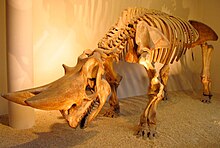Embrithopoda
| Embrithopoda Temporal range: Eocene - Oligocene, 35–28 Ma |
|
|---|---|
 |
|
| Arsinoitherium zitteli | |
| Scientific classification | |
| Kingdom: | Animalia |
| Phylum: | Chordata |
| Class: | Mammalia |
| Clade: | Paenungulata |
| Order: |
†Embrithopoda Andrews 1906 |
| Families | |
Embrithopoda ("heavy-footed") is an order of extinct mammals known from Asia, Africa and eastern Europe. Most of the embrithopod genera are known exclusively from jaws and teeth dated from the late Paleocene to the late Eocene, but the order is best known from its terminal member, the elephantine Arsinoitherium.
While embrithopods bore a superficial resemblance to rhinoceroses, their horns had bony cores covered in keratinized skin and were not made of hair. Not all embrithopods possessed horns, either. Despite their appearance, they were related to elephants, not perissodactyls.
The Embrithopoda are tethytheres and are also believed to be part of the clade Afrotheria. However, a new study of the basal arsinoitheriid, Palaeoamasia, suggests that embrithopods are not tethytheres or even paenungulates, and that they need to be better sampled in an analysis of eutherian relationships to clarify if they are even afrotherians.
Fossils of embrithopods, such as Arsinoitherium, have been found in Egypt, Mongolia, Turkey, Romania, Namibia and Tunisia. Until the 1970s, only Arsinoitherium itself was known, appearing isolated in the fossil record.
McKenna & Manning 1977 and McKenna & Bell 1997 considered Phenacolophus from Mongolia a primitive embrithopod, although this attribution was challenged by several other authors. A 2016 cladistic study, however, confirmed the original embrithopod placement of Phenacolophus.
...
Wikipedia
